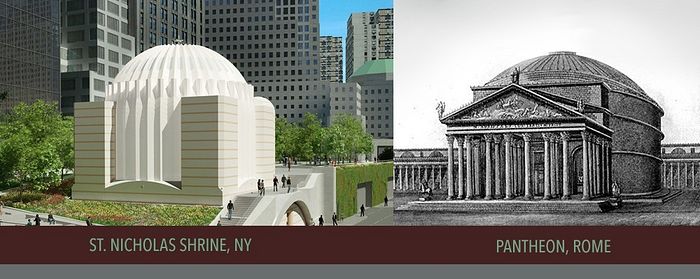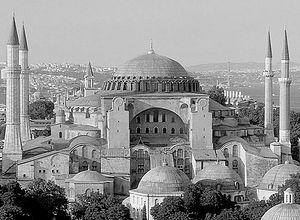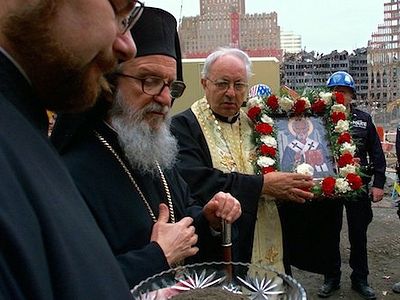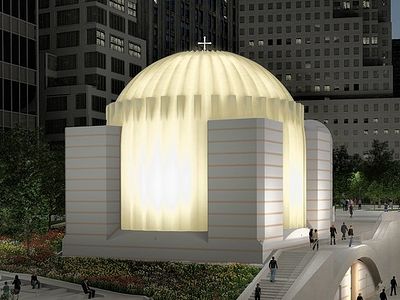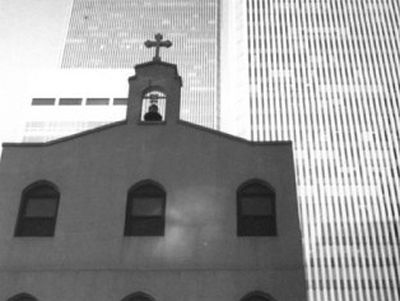Source: Orthodox Witness
February 12, 2016
Rev. John Romas, pastor of St. Nicholas Greek Orthodox Church in Lower Manhattan for 30 years, died of pancreatic cancer on Jan. 24, 2016. Had he not died of cancer, he would have died today of a heart attack, seeing his beloved church eclipsed by the erection of the new St. Nicholas, a glitzy new edifice, bearing no resemblance to his humble church, except for the name.
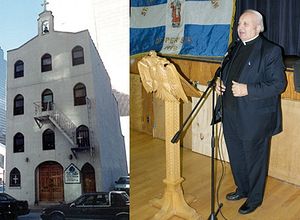 Rev. John Romas was the pastor of St. Nicholas Greek Orthodox Church on 155 Cedar Street in Lower Manhattan for 30 years. His small church was completely destroyed on Sept. 11, 2001 when the South Tower collapsed. “I was crying like a baby,” Father Romas is quoted to have said at the time.
Rev. John Romas was the pastor of St. Nicholas Greek Orthodox Church on 155 Cedar Street in Lower Manhattan for 30 years. His small church was completely destroyed on Sept. 11, 2001 when the South Tower collapsed. “I was crying like a baby,” Father Romas is quoted to have said at the time.
Come to think of it, the Port Authority of New York and New Jersey has been most generous to agree to keep the name of St. Nicholas. The media has also quoted Archbishop Demetrios as having said that “he envisions not just a rebuilt parochial church on its old 22-by-55-foot site but something greater: a memorial shrine open to all visitors.”
“There is the exciting possibility of having something additional,” he added, “enhancing and enlarging the function from a purely Orthodox liturgical church to one offering counseling, support and interreligious meetings.”
I think he was forced to say all these things to save face. Still, these statements of his are truly troubling. Here is another of his statements: “With the grace of God…it will soon rise like a glorious phoenix as a National Shrine and a place of pilgrimage for our Nation. It will be a place of faith, a place of peace and a place of solace and hope.”
How wonderful! Now, not just Orthodox Christians, but Christians of every denomination, and in fact people of almost every religion can flock to do their devotions, being Moslems, Bahá’í, Buddists, Hindu or Taoists. Even Shamanists, Satanists and atheists would be welcome.
The desire of the Greek Orthodox Church is to create a space in which all visitors will feel welcome. A spokesman for the archdiocese, the Rev. Mark Arey, stated:
If I may quote Jesus, “My house shall be called a house of prayer for all people.” It will be open to everyone: the believer, the unbeliever, the Orthodox Christian, the atheist. Whoever you are, this is a space that you can come into and find some meditative solace.
I find Fr. Arey’s understanding of the words of the Lord (as reported by the Evangelist) to be a distortion and a misapplication. The evangelist (Mark 11:1) was quoting prophet Isaiah (56:7), who was looking forward to a time when not just the Jews, but people from all nations who had accepted the true God and had joined themselves to the Lord, would be gathered together in His holy mountain to offer acceptable offerings and sacrifices.
The Church continues to invite and call “others to Him besides those already gathered” (Is. 56:8, cf. also Ez. 34:6.12), just as Her Founder did (see John 10:16), who wants to bring into the fold of His Church all the scattered sheep. But they must be receptive to “listen to His voice” (John 10:4) and follow Him, so that they may become one. “The Church of the living God, the pillar and foundation of the Truth” (1 Tim. 3:15), is composed of the faithful, who have accepted Christ, and have become members of His Body. In such an assembly what room is there for “unbelievers” and “atheists”?
On holy Epiphany this year (Jan. 5, 2016) the Archbishop spoke about the millions upon millions of people expected to visit the Memorial at Ground Zero, many of whom would also visit the Shrine. It would offer, he said, a great opportunity to our Orthodox Church to witness our faith to the world. But is this going to be the case? I’m afraid not, and I pray with all my heart that I’ll be proven wrong.
Going back to the words of Fr. Arey (which reflect those of the Archbishop), is “meditative solace” what our Orthodox Church wants to provide to people? Is this what this pantheistic or rather humanistic temple is being built for? Are we competing with yoga and Oriental religions? Are we now in the self-help business of alleviating stress, bringing peacefulness to our lives, finding our inner self, seeking experiences and sensations, and the like? If we are, it would be better if this temple were never completed, because it would have no resemblance to the Church, and would lead people astray instead of leading them to Christ, Who is the Truth.
One more thing: the design of the exterior of the Church only vaguely resembles the celebrated temple of Hagia Sophia, constructed by Emperor Justinian in Constantinople (present-day Istanbul, Turkey; actually). Actually, it resembles more the great Church as it presently stands, because the four massive surrounding pylons resemble the minarets of a mosque.
A few more questions are raised: Will the cupola be adorned with a miniscule cross, as it is shown in the model, which is almost invisible? As far as the interior is concerned, I have not seen any plan, other than what was shown in a BBC short video, but I have serious doubts it will be modeled after the spectacular mosaics and frescos of the real Hagia Sophia and the Church of the Holy Savior in Chora (again, I hope I’ll be proven wrong).
The Orthodox people who are sending their donations believe their money goes to the erection of an Orthodox church, not an ecumenistic and syncretistic temple. The name shown on the Philoptochos website (above the big DONATE button) reads: “Saint Nicholas Greek Orthodox Church and National Shrine at the World Trade Center.” The same name appears twice underneath it. I find the name, St. Nicholas National Shrine, to be a betrayal of their trust.
In its April, 2014 issue, the Orthodox Observer ran an article entitled, “Our American ‘Parthenon’.” I have a more appropriate name for it: “Our American Pantheon.”
